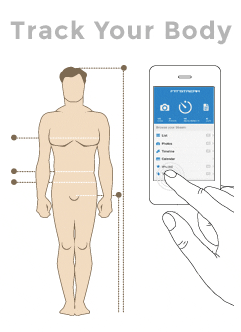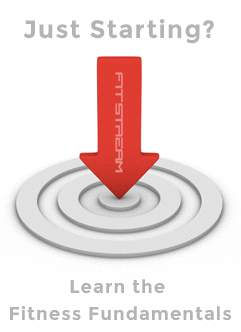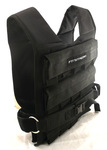
Weighted club training and fitness
Club training is a unique form of exercise with weighted clubs (or Indian Clubs as they are often known) which effectively blends strength and cardio based exercise making it a highly efficient form of training.
Predating the barbell and dumbbell, the weighted club is once again changing bodies around the world as we rediscover the benefits of old school, "primitive fitness"... and strength training tools don't come much more primitive than the club.
The weighted clubs used for fitness training are essentially solid baseball bats (often available in steel and sometimes wood) with a handle and rounded knob for gripping. The clubs are lifted and swung in various exercise patters that is often compared to kettlebell training.
The club is an unwieldy tool that takes coordinated muscular effort to lift, control and manipulate. The main benefits of club training are for time efficient fat burning workouts, and that they're excellent for developing shoulder flexibility and strength.
Club swinging is a historic form of exercise that athletes have used to dramatically improve strength, flexibility and endurance. This form of training has been around for hundreds of years but was lost to the commercial gym era and has recently came back to modern gyms around the world due to its effectiveness as a all-round fitness and strength training aid.
Club training is commonly referred to as ‘Circular Strength’, and owes its resurgence into mainstream fitness to top fitness expert Scott Sonnon who has helped popularize the club workout and patented the Clubbell, pictured below.
Clubs offer the perfect means for incremental progression by changing your grip location on the handle of the club you alter the difficulty of the exercise by the amount of leveraged weight called into play. This is essential for staying injury free and putting you in control of the exercise, whilst making continuous strength gains and avoiding training plateaus.
The further your grip is from the weighted end of the club the greater the weight employed for the exercise. It's a flexible design which means that you aren't confined to the large and sometimes dangerous jumps in plate weight from traditional strength equipment.
The benefits of club training
Essentially, club training is the ultimate form of shoulder strength training and helps to build tremendous upper-body musculature with an exceptional grip.
Club workout benefits -
- Develop shoulder stability through strength, endurance and flexibility gains
- Highly effective grip strength and wrist training
- Functional training that promotes overall upper-body development
- Excellent for sports specific training like tennis, martial arts, golf and swimming.
- Great for developing good posture by working the back and shoulder muscles.
- Portable training equipment
- Scalable training by altering the position of the hands and therefore leverage of the weight involved
Club workouts offer movement in multiple planes and are excellent for balancing out the muscles that are rarely targeted by more traditional training methods. To say that that club offer compound training is an understatement!
In addition to this, many people find club training to be fun and quite addictive. It’s a challenging, yet interesting way to exercise that breaks away from the norm. These natural body movements with weighted clubs can be used to develop your entire body, rotator cuff stability and overall timing and coordination.
Choosing club weight
If you're looking to buy a fitness club, one of the first questions you'll have is on what club weight you'll need. Please see our Clubbell guide to weight selection below broken down by fitness goal.
| Profile | Club weight for flexibility and mobility | Club weight for strength and grip |
|---|---|---|
| Average man | 2kg / 5lbs | 6kg / 10lbs |
| Stronger than average man | 4 or 2kg / 10 or 5lbs | 6 or 8kg / 10 or 15lbs |
| Very strong man | 4kg / 10lbs | 8 or 10kg / 15lbs or 20lbs + |
| Average woman | 2kg / 5lbs | 4kg / 10lbs |
| Strong woman | 2kg / 5lbs | 4kg / 10lbs |
It is recommend that men in good shape should start with two 6kg clubs and maybe the 8kg club if you are very strong, and 10kg club only if you have a thorough strength training background and are exceptionally strong. For two handed training, male beginners can use one 10kg club and athletic males a 15kg club.
If you are concentrating mainly on joint mobility you may like to start with a set of 2-4kg.
Physically fit women can start with two 4kg weighted clubs. If you're just starting out you can begin with the 2kg clubs and work up from there. For two handed female training try the 6kg for beginners and 10kg if you are athletic.
Please note - These weights may seem light, but try and avoid going too heavy as it's a common mistake for beginners. 6kg may sound light in the context of traditional weight training, but you don't swing the weights around in weight training and the club weight does feel remarkably heavy when you get going.
Club exercises
Clubs can be used for a huge selection of exercises that can target the entire body, developing strength, lean muscle, and promoting weight loss by perfectly blending cardio and weight training.

Here are a couple of club exercises from the directory page, and we'll be building on these in the coming months...
- Club Swing: The most basic of club exercises and a great place to start for the beginner.
- Front pendulum: A solid conditioning exercise that adds complexity to the standard club swing.
Please note that it's highly important you adhere to proper form and correct technique when club training and if you're inexperienced it's recommended that you receive guidance from an approved instructor or study a training DVD or book.
When club training;
- Ensure that you have enough space around you to train safely (about six feet in all directions to err on the side of caution).
- Use a weight you can handle! Read our club weight guide above for pointers and do research to find what is best for you.
History of club training
Club training has a rich history dating back for centuries as indian clubs were used in the late 1800s. The indian clubs were usually made from wood, available in varying sizes and weights. These clubs were swung around in different rhythms and routines. The heavier clubs were used to develop physical strength, while the lighter clubs were used for shoulder flexibility and coordination.
Believed to have been introduced by British soldiers stationed in India in the 1800's the clubs were used to keep the soldiers in top physical condition, challenging their strength agility, balance and flexibility traits. The soldiers reveled in the effectiveness of the Indian Clubs and brought them to Europe where they first became popular in Germany and Czechoslovakia as more and more people integrated them into their physical fitness routines.
Club training spread around the globe where they were even introduced into school physical education programs and US military training.

The 1914 United States Army Manual of Physical Training stated that:
“The effect of these exercises, when performed with light clubs, is chiefly a neural one, hence they are primary factors in the development of grace and coordination and rhythm. As they tend supple the muscles and articulation of the shoulders and to the upper and fore arms and wrist, they are indicated in cases where there is a tendency toward what is ordinarily known as "muscle bound." (p.113)
Club training actually featured as an Olympic sport in 1904 but gradually waned from mainstream use in the first two decades of the 20th century.
Now the clubs are making a comeback. Club swinging is coming back to the fore of fitness and catching on rapidly as individuals, trainers and gyms discover how enjoyable and effective club training can be.
Club training summary
Club training offers a potent workout that combines strength training with cardio for maximum effectiveness. Training with clubs will help you build strength and definition, whilst burning off excess fat but along with the physical benefits there's just something very satisfying about training with this very raw and primitive tool.
The club swinging exercises offer a form of training that's both graceful, yet brutal and ultimately exhausting. It's refreshing to train so fluidly, with exercises flowing into one another in a medley of coordinated movements.
If you enjoy kettlebell training then you'll most likely enjoy training with clubs.
Club training is impressive to watch and even more fun to perform. It's addictive and effective and is particularly useful for those wishing to build strength and stability in their shoulders and upper body.










